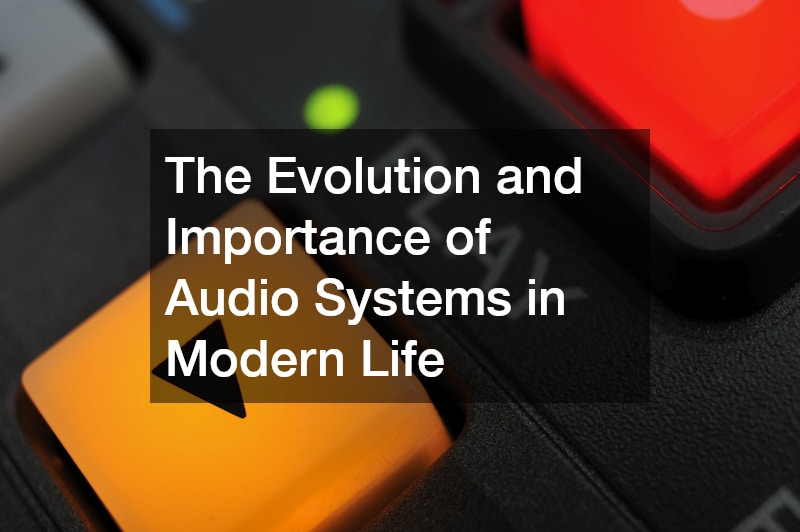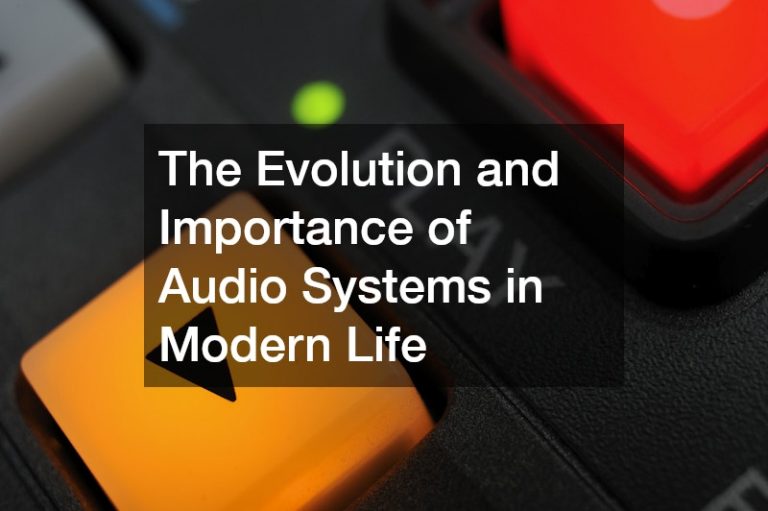

Audio systems have become a fundamental part of everyday living, shaping the way we communicate, learn, and entertain ourselves. From the earliest radios to today’s advanced wireless surround setups, the evolution of sound technology continues to redefine how people experience music, movies, and even daily tasks. These systems are no longer just accessories; they serve as gateways to immersive environments, connecting individuals with the world around them in powerful and engaging ways.
A Brief History of Audio Systems
The story of audio systems begins in the late 19th and early 20th centuries with the invention of the phonograph and radio. These early devices transformed society by making sound accessible outside live performances. Families gathered around radios to hear news broadcasts and music, creating shared experiences that became central to culture.
As decades passed, advances such as vinyl records, cassette tapes, and compact discs each represented milestones in how sound was recorded, stored, and shared. The late 20th century ushered in digital audio, giving rise to MP3 players, home theater systems, and eventually, streaming services that could deliver sound instantly from anywhere in the world.
Core Components of an Audio System
At its heart, an audio system is a combination of equipment designed to capture, process, and reproduce sound. While specific setups vary widely depending on purpose, most include several core components:
-
Source devices: These provide the content, whether it’s a record player, CD player, smartphone, or streaming platform.
-
Amplifiers: Amplifiers take the weak audio signals from the source and boost them to a level capable of driving speakers.
-
Speakers: Responsible for translating electrical signals into sound waves, speakers are essential for delivering clarity and depth.
-
Receivers: In many systems, receivers act as the central hub, connecting multiple devices and managing audio distribution.
When these components are well-matched, they deliver sound that feels natural, balanced, and immersive.
The Role of Audio Systems in Home Entertainment
In today’s homes, audio systems play a central role in creating entertainment experiences. A high-quality setup can transform an ordinary living room into a personal cinema or concert hall. With advancements in surround sound, subwoofers, and wireless speakers, households can now enjoy rich, room-filling sound without the clutter of traditional wired setups.
Streaming platforms and smart TVs integrate seamlessly with modern systems, allowing people to enjoy movies, sports, or gaming with crystal-clear soundscapes. This creates a deeper emotional connection to content, enhancing both storytelling and excitement.
Audio Systems in Everyday Environments
Beyond entertainment, audio systems influence many everyday environments. In cars, they make commuting more enjoyable by delivering crisp music, podcasts, or hands-free communication. In workplaces, they support presentations, training sessions, and remote meetings. Public spaces such as airports, stadiums, and shopping centers rely on carefully designed audio setups to ensure announcements are clear and heard across large areas.
Even in healthcare and education, audio systems play crucial roles. Teachers use them to ensure every student can hear lectures, while hospitals rely on them for communication and patient comfort. These examples highlight how sound systems extend far beyond leisure, providing functionality that impacts efficiency and safety.
The Rise of Smart and Wireless Technology
One of the most significant trends in recent years is the shift toward smart and wireless technology. Wi-Fi and Bluetooth connectivity have removed the limitations of cables, offering flexibility and convenience. Smart speakers with built-in assistants allow users to control music, lighting, and even household appliances through voice commands.
This integration of artificial intelligence into audio systems marks a new era where sound technology is not just about playback but also about interaction. People can ask for news updates, set reminders, or control other smart devices simply by speaking.
Designing for Personal and Professional Use
Modern audio systems are versatile, designed to meet both personal and professional needs. For personal use, portable speakers and noise-canceling headphones provide immersive sound experiences on the go. For professional environments such as recording studios or conference rooms, systems emphasize precision and clarity to ensure the highest quality.
Custom setups are increasingly common, allowing users to tailor sound environments to their preferences. Some may prioritize deep bass for music, while others value dialogue clarity for films or conferences. The ability to adjust and optimize makes today’s systems adaptable to nearly any scenario.
The Psychology of Sound
Sound influences mood, behavior, and memory, which makes audio systems more than just technical devices. The right soundscape can relax, energize, or inspire people. In retail, stores use background music to encourage longer visits, while gyms rely on high-energy playlists to motivate workouts. At home, calming soundtracks can improve relaxation and focus.
This psychological impact underscores why quality sound reproduction is important. It transforms everyday experiences into something more engaging and meaningful.
Looking Ahead: The Future of Audio
As technology advances, the future of audio systems promises even more innovation. Spatial audio and 3D sound are already creating hyper-realistic environments, especially in gaming and virtual reality. Advances in miniaturization mean that smaller devices will deliver even greater sound power and clarity.
Sustainability is also emerging as a priority, with manufacturers exploring eco-friendly materials and energy-efficient designs. The balance between performance and environmental responsibility will likely shape the next generation of sound systems.
From their humble beginnings to today’s sophisticated smart devices, audio systems continue to evolve as vital parts of modern life. They shape how people connect with entertainment, communicate in daily environments, and even influence emotions and behavior. As innovation pushes forward, these systems will only grow more immersive, interactive, and essential, ensuring that sound remains at the heart of human experience.






